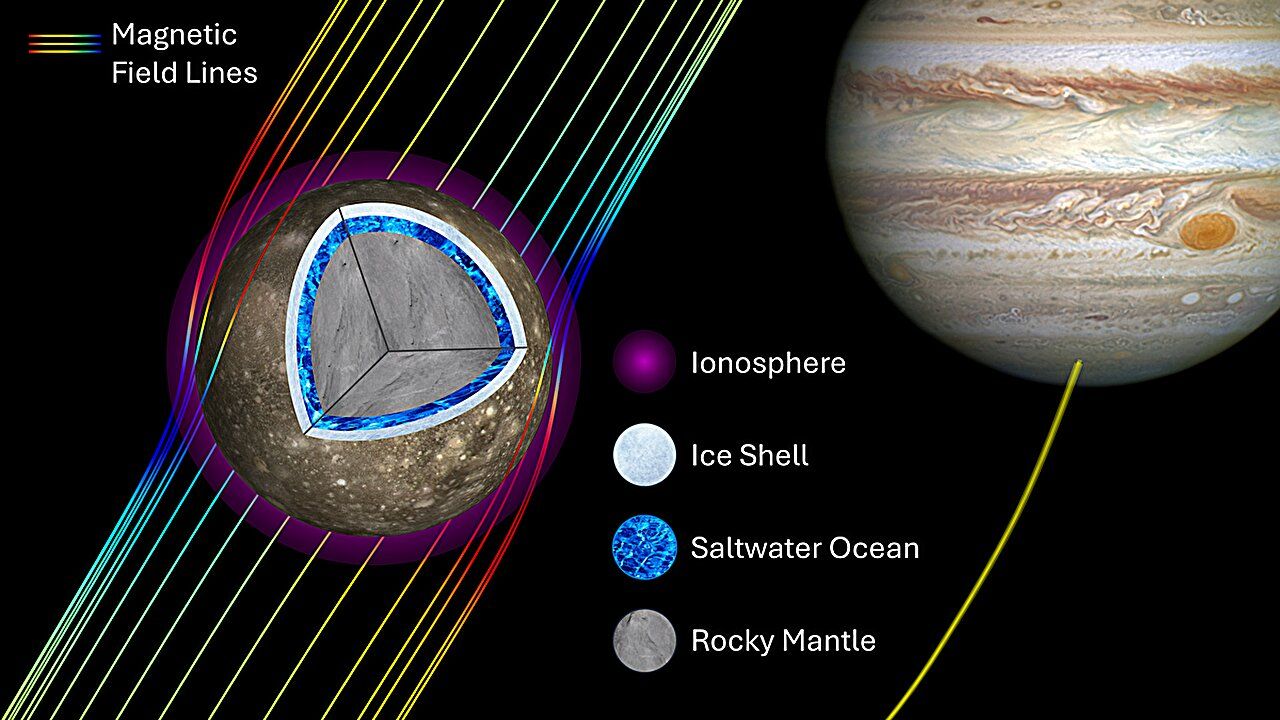Callisto may hide a salty ocean 🌊
Follow us on Google News (click on ☆)
Callisto, the second-largest moon of Jupiter, is covered in craters and appears, at first glance, geologically inactive. However, magnetic measurements taken by the Galileo probe in the 1990s suggest the presence of a salty ocean beneath its icy surface. This hypothesis, long debated, is gaining credibility thanks to a new in-depth study.

Callisto (left) and Jupiter (right).
Credit: Corey J. Cochrane, NASA/JPL-Caltech.
Researchers re-examined Galileo's data using advanced statistical techniques and computer models. They found that Callisto's ionosphere alone cannot explain the magnetic observations. The presence of a subsurface ocean, on the other hand, perfectly completes the picture. This ocean, located beneath a thick layer of ice, could extend for several tens of miles.
This study, published in AGU Advances, opens new perspectives for future space missions. NASA's Europa Clipper mission, the European Space Agency's JUICE mission, and China's Tianwen-4 mission could provide definitive answers. These missions will help confirm the presence of this ocean and explore its potential to harbor life.
The confirmation of an ocean on Callisto would be a major breakthrough for planetary science. It could also reignite interest in the search for extraterrestrial life in our solar system. Callisto, long considered a dead moon, might well turn out to be an ocean world.
The implications of this discovery are vast. Not only does it enrich our understanding of Callisto, but it also highlights the importance of space missions in exploring ocean worlds. These missions could teach us more about the conditions necessary for the emergence and sustenance of life.
While awaiting the results of these missions, scientists continue to analyze existing data. Each new discovery brings us a little closer to understanding the mysteries of our solar system and, perhaps, life beyond our planet.
How do subsurface oceans influence magnetic fields?
Subsurface oceans, like the one potentially present on Callisto, can influence magnetic fields in several ways. First, saltwater is a good electrical conductor, meaning it can generate electric currents in response to a varying magnetic field. These currents, in turn, produce their own magnetic field, which can be detected by instruments like those on the Galileo probe.
Second, the presence of a subsurface ocean alters how the magnetic field interacts with its space environment. This can lead to specific variations in magnetic measurements, which can be interpreted as clues to the presence of liquid water beneath the surface.
Additionally, studying these magnetic interactions allows scientists to deduce physical properties of the ocean, such as its depth and salinity. This information is crucial for understanding not only the internal structure of moons and planets but also their potential to harbor life.
Why does Callisto's ionosphere complicate the detection of a subsurface ocean?
Callisto's ionosphere, an electrically charged layer of the atmosphere, poses a particular challenge for detecting a subsurface ocean. This layer is itself conductive and can therefore influence magnetic measurements in a way similar to a subsurface ocean. This makes it difficult to distinguish between the magnetic effects produced by the ionosphere and those produced by an ocean beneath the surface.
To overcome this problem, scientists use computer models that simulate the properties of the ionosphere and compare them to observations. By adjusting these models to account for all available data, they can isolate the magnetic signatures specific to a subsurface ocean.
This approach requires a deep understanding of the physical processes at play in the ionosphere and subsurface oceans. It also illustrates the importance of advanced statistical techniques and numerical simulations in interpreting space data.